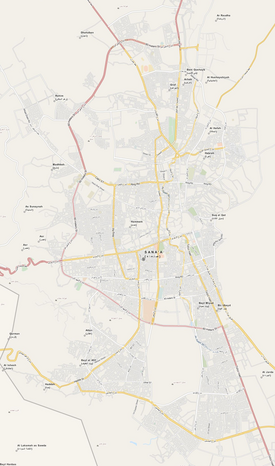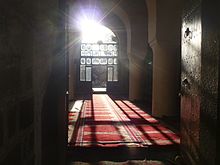
Islamic architecture comprises the architectural styles of buildings associated with Islam. It encompasses both secular and religious styles from the early history of Islam to the present day. The Islamic world encompasses a wide geographic area historically ranging from western Africa and Europe to eastern Asia. Certain commonalities are shared by Islamic architectural styles across all these regions, but over time different regions developed their own styles according to local materials and techniques, local dynasties and patrons, different regional centers of artistic production, and sometimes different religious affiliations.

The Mosque–Cathedral of Córdoba, officially known by its ecclesiastical name of Cathedral of Our Lady of the Assumption, is the cathedral of the Diocese of Córdoba dedicated to the Assumption of Mary and located in the Spanish region of Andalusia. Due to its status as a former mosque, it is also known as the Mezquita and as the Great Mosque of Córdoba.
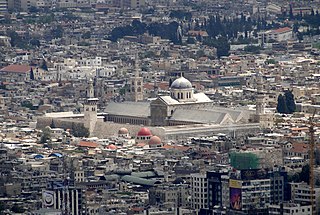
The Umayyad Mosque, also known as the Great Mosque of Damascus, located in the old city of Damascus, the capital of Syria, is one of the largest and oldest mosques in the world. Its religious importance stems from the eschatological reports concerning the mosque, and historic events associated with it. Christian and Muslim tradition alike consider it the burial place of John the Baptist's head, a tradition originating in the 6th century. Two shrines inside the premises commemorate the Islamic prophet Muhammad's grandson Husayn ibn Ali, whose martyrdom is frequently compared to that of John the Baptist and Jesus.
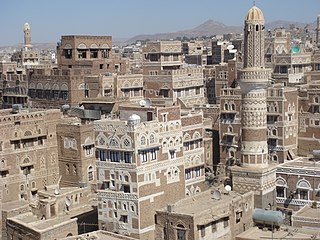
The architecture of Yemen dates back to ancient times, when it was part of a tradition of South Arabian architecture. Developments continued during the Islamic period, displaying both local characteristics and external influences. The historic cities and towns of Yemen are known for their traditional tower-houses.

The Sanaa palimpsest or Sanaa Quran is one of the oldest Quranic manuscripts in existence. Part of a sizable cache of Quranic and non-Quranic fragments discovered in Yemen during a 1972 restoration of the Great Mosque of Sanaa, the manuscript was identified as a palimpsest Quran in 1981 as it is written on parchment and comprises two layers of text.

The Great Mosque of Tlemcen is a major historic mosque in Tlemcen, Algeria. It was founded and first built in 1082 but modified and embellished several times afterwards. It is considered one of the most important examples of architecture under the Almoravid dynasty.The mosque saw major extensions to both the building and the construction of the minaret by the Zayyanid dynasty.

The Great Mosque of Aleppo is the largest and one of the oldest mosques in the city of Aleppo, Syria. It is located in al-Jalloum district of the Ancient City of Aleppo, a World Heritage Site, near the entrance to Al-Madina Souq. The mosque is purportedly home to the remains of Zechariah, the father of John the Baptist, both of whom are revered in Islam and Christianity. It was built in the beginning of the 8th century CE. However, the current building dates back to the 11th through 14th centuries. The minaret in the mosque was built in 1090, and was destroyed during fighting in the Syrian Civil War in April 2013.

The White Mosque was an Umayyad-era mosque located in Ramle, Israel. Only its minaret is still standing. According to local Islamic tradition, the northwestern section of the mosque contained the shrine of an Islamic prophet, Salih.

The Old City of Sanaʽa is a recognised UNESCO World Heritage Site in the Amanat Al Asimah Governorate, Yemen. As of 2003, the district had a population of 63,398 inhabitants. The old fortified city has been inhabited for more than 2,500 years and contains many intact architectural sites. The oldest, partially standing architectural structure in the Old City of Sanaʽa is Ghumdan Palace. The city was declared a World Heritage Site by the United Nations in 1986. Efforts are underway to preserve some of the oldest buildings some of which, such as the Samsarh and the Great Mosque of Sanaʽa, is more than 1,400 years old. Surrounded by ancient clay walls that stand 9–14 metres (30–46 ft) high, the Old City contains more than 100 mosques, 12 hammams (baths), and 6,500 houses. Many of the houses resemble ancient skyscrapers, reaching several stories high and topped with flat roofs. They are decorated with elaborate friezes and intricately carved frames and stained-glass windows.

Ghumdan Palace, also Qasir Ghumdan or Ghamdan Palace, is an ancient fortified palace in Sana'a, Yemen. All that remains of the ancient site of Ghumdan is a field of tangled ruins opposite the first and second of the eastern doors of the Jami‘ Al Kabeer Mosque. This part of Sana'a forms an eminence which is known to contain the debris of ancient times. The place is located on the extreme southeastern end of Sanaa's old walled city, al-Qaṣr, just west of where the Great Mosque of Sana'a was later built, and is part of the UNESCO World Heritage Site of the Old City of Sana'a. It is sometimes referred to as Ghumdan Tower.

The Fatimid architecture that developed in the Fatimid Caliphate (909–1167 CE) of North Africa combined elements of eastern and western architecture, drawing on Abbasid architecture, Byzantine, Ancient Egyptian, Coptic architecture and North African traditions; it bridged early Islamic styles and the medieval architecture of the Mamluks of Egypt, introducing many innovations.

Abbasid architecture developed in the Abbasid Caliphate, primarily in its heartland of Mesopotamia. The great changes of the Abbasid era can be characterized as at the same time political, geo-political and cultural. The Abbasid period starts with the destruction of the Umayyad ruling family and its replacement by the Abbasids, and the position of power is shifted to the Mesopotamian area. As a result there was a corresponding displacement of the influence of classical and Byzantine artistic and cultural standards in favor of local Mesopotamian models as well as Persian. The Abbasids evolved distinctive styles of their own, particularly in decoration. This occurred mainly during the period corresponding with their power and prosperity between 750 and 932.

Talha Mosque or Qubbat Talha, one of the oldest mosques in Sana'a (Yemen), was built by order of the Ottoman Wali Hadji Mehmed Pasha from 1619 to 1620, during the first Ottoman occupation. The minaret was built at the same time.
The following is a timeline of the history of the city of Sana'a, Yemen.

Madrasa and Mosque of Al-Ashrafiya or Al-Ashrafiya Mosque is a historical madrasa-mosque located in the old city of Taiz, Yemen at the foot of Mount Sabr in the southwestern part of the city. It is arguably the most notable preserved artifact of Taiz, given its distinct and beautiful design. It is considered to be one of the most important centers in the Islamic history of Yemen along with its complement, the Mudhaffar Mosque. It was supposedly built in two stages: (1) by Sultan Al-Ashraf Umar II (1295-6) or 800 Hijri, (2) by Sultan Al-Ashraf Isma'il I (1377-1400) and opened in 1382 or 803 Hijri. This compound can be found in the neighborhood of Ashrafiya, surrounded by a number of other locations and overlooks the Cairo Citadel. The mosque accommodates approximately 120 to 800 worshippers.
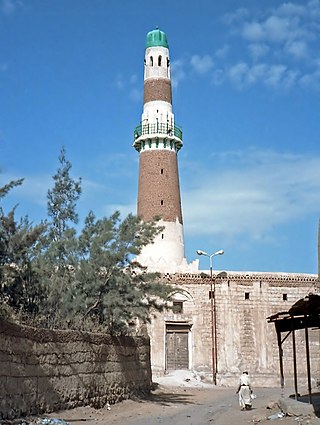
Al-Hadi Mosque or Al-Imam Al-Hadi Mosque is one of the historical mosques of the ancient city of Sa'ada, Yemen. It is located east–west of the city, was built in around 897 C.E., and is named after Imam Yahya Bin Al-Hussein, the founder of the state of Imams of Yemen. The mosque became the oldest place for the teaching of Zaidi maddhab in the Arabian Peninsula.
The Great Mosque of Zabid is a historic congregational mosque in the old city of Zabid, Yemen.

The Great Mosque of Sousse is a historical mosque in the coastal city of Sousse, Tunisia. The construction dates back to 851, during the rule of the Aghlabid dynasty, vassals of the Abbasid Caliphate. It was commissioned by the ruler Abu al-‘Abbas Muhammad al-Aghlabi. It is a major monument of Aghlabid architecture in the early Islamic period. The mosque was renovated and its prayer hall expanded multiple times over the following centuries.

The Mosque of the Andalusians or Al-Andalusiyyin Mosque, sometimes also called the Andalusian Mosque, is a major historic mosque in Fes el Bali, the old medina quarter of Fez, Morocco. The mosque was founded in 859–860, making it one of the oldest mosques in Morocco. It is located at the heart of a district which was historically associated with Andalusi immigrants, from which it takes its name. It has been renovated and expanded several times since then. Today, it is one of the relatively few remaining Idrisid-era establishments and one of the main landmarks of the city.

Aghlabid architecture dates to the rule of the Aghlabid dynasty in Ifriqiya during the 9th century and the beginning of the 10th century. The dynasty ruled nominally on behalf of the Abbasid Caliphs, with which they shared many political and cultural connections. Their architecture was heavily influenced by older antique architecture in the region as well as by contemporary Abbasid architecture in the east. The Aghlabid period is also distinguished by a relatively large number of monuments that have survived to the present day, a situation unusual for early Islamic architecture. One of the most important monuments of this period, the Great Mosque of Kairouan, was a model for mosque architecture in the region. It features one of the oldest minarets and contains one of the oldest surviving mihrabs in Islamic architecture.

